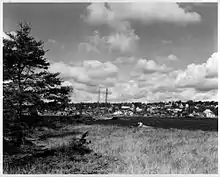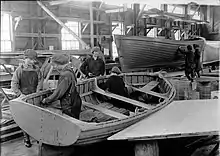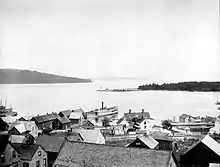History of Baddeck
Baddeck, Nova Scotia is a village founded in 1908, with a history stretching back to early Mi'kmaq, French and British settlements. The village was home to Alexander Graham Bell and was witness to the first flight in the commonwealth with Bell's Silver Dart.
Early settlement
_p124_Indian_Camp_at_Baddeck.jpg.webp)
The name "Baddeck" is believed to originate from a Mi'kmaq word. One theory is that it originates from the word "Abadek" or "Abadak", which means "a portion of food set aside for someone or a sultry place" while another theory is that it originates from a word meaning "place with an island near".[1][2][3]
Europeans discovered the inland part of Cape Breton Island during the 17th century when Jesuit missionaries from France established a settlement at nearby St. Anns in 1629. British settlement came during the 18th century after the territory was ceded by France; a United Empire Loyalist Cpt. Jonathan Jones (retired British Army) and his family arrived in 1790 and were given a Crown land grant in the Baddeck River valley. They were followed by other Loyalists and immigrants from Scotland.
Island settlement
In 1819, Lt. James Duffus (half pay Naval Officer), whose brother-in-law was Sir Samuel Cunard founder of the Cunard Line of steamships, founded his home on what is now known as Kidston Island—then known as Mutton Island—off the shore of present-day Baddeck.[1] Duffus renamed the island Duke of Kent's Island, in honour of his patron.[1] Duffus operated a mercantile business on the island, serving people from River Baddeck and Grand Narrows; customers were ferried to the island by canoe.[1] In 1820 Duffus was appointed a magistrate and in 1826 he was granted 400 acres on the mainland.[1] Duffus died in 1833, and his former assistants operated the business for a little over two years.[1] In 1836 the executors of his estate in Halifax sent William Kidston to wind up his business.[1] While here he met and ended up marrying Margaret Ann Duffus, widow of James Duffus, in 1836. The Kidston business was moved to the mainland in 1840 and was later taken over by a gentleman from Colchester County named Angus Tupper.
Early village history
The history of the village proper began in 1839 with the settlement of two families on the mainland. The first was that of Joseph Campbell, a native of Newry, Ireland who built an Inn on a property near Indian Cove. The Inn also contained a tavern and a Post Office, and Mr. Campbell became Baddeck's first Post Master. Mail was brought from Sydney by carriers on foot with the mail bags on their backs. Mr. Campbell later moved to the United States. The second family was that of Hector MacLean of Scotland who built his home on the property adjoining the old Knox Cemetery on the Bay Road. Between these two homesteads there were no other residences but the wigwams of the Indians along the shore of the Lake.
In 1841, Mr. Charles James Campbell, who in later years was known far and wide as the Hon. C. J. Campbell, opened a store on the waterfront. He catered to the large Scottish trade in the area and across the lake in Boisdale, Iona, Grand Narrows, and Washabuck. He swept all opposition before him for was he not a Highlander, speaking Gaelic as his mother tongue. The Hon. Mr. Campbell who was largely responsible for the growth of the village. In addition to his mercantile business he undertook shipbuilding and turned out many large ships between 1844 and 1881. He also developed the Kelly's Cove coal deposits and built his home which later became the Hotel Baddeck which eventually burned down. He named it 'Duntulum House', a name now given to one of our streets and where now stands the Alderwood Rest Home. He also donated the land for the new cemetery and was one of the first to be interred there. The settlement of New Campbellton was named in his honor and for many years his face looked out from a plaque above the door of 'Gertrude Hall' which was destroyed by fire in 1939.
Growth of the village
Shire town
Up until 1851 Baddeck was known as Little Baddeck and it was part of Cape Breton County.[1][4] William Kidston advocated the separation of Cape Breton County.[1] In 1851 Kidston's advocacy paid off and Victoria County was split off from Cape Breton county and Baddeck became known by its present name.[4] Kidston also advocated for Baddeck to become the site for the new county's jail and court house,[1] which happened when Baddeck was established as the shire town of the county.[4] When Baddeck became the shire town of the county, it established a municipal council and Murdoch MacAskill became the village custos rotulorum.[5] The Victoria County Court House was finally constructed in 1889.[6]

Baddeck, And that Sort of Thing
Baddeck rose to fame in 1874, with the publication of Baddeck, And That Sort of Thing by American writer and associate of Mark Twain, Charles Dudley Warner. Warner had visited Baddeck the previous year with Joseph Twichell and documented the voyage in the book.[7] Warner stayed at the Telegraph House during his visit,[8] a hotel built in 1861 and that still operates today.[9] Warner described Baddeck as a "clean-looking village of white wooden houses, of perhaps seven or eight hundred inhabitants".[8] Warner attended a church service at the kirk near the water. This church would have been Knox Church, a Presbyterian church built on Bay Road in 1857.[10] He describes the church as being similar in appearance to a New England meeting house, with a pretty wooden spire and a plain, ugly interior. Warner also visited the county jail in Baddeck, which at the time was housing a single prisoner—a carpenter who was permitted to have a workbench and newspapers.[8] The jail had four rooms on the ground floor and an attic with a "sleeping-room". The jailer's family was, at the time, staying in one of the empty cells.[8] In addition to the church and jail, Warner describes Baddeck as having "very good schools" on par with those in Boston.[8] Other travel books followed Warner's publication. In 1885 Samuel Greene Wheeler Benjamin published The Cruise of the Alice May in the Gulf of St. Lawrence and Adjacent Waters which included a description of Baddeck. According to Benjamin, Baddeck at this time consisted of highlanders—many of whom spoke only Gaelic.[11]
Alexander Graham Bell era
In 1885, Alexander Graham Bell, his wife Mabel, and their two young daughters, arrived by boat via the St. Peters Canal. They fell in love with Baddeck and built two homes on their estate, which they named "Beinn Bhreagh" (Gaelic for 'Beautiful Mountain'), as well as another Bell Laboratory, an additional namesake to AT&T's Bell Laboratories many years later. Dr. Bell and his family helped the people of the village begin a new era. Alec Bell, who was a Scot and could speak Gaelic, took Baddeck to heart and made their home a gathering place for the village. Alec and his wife Mabel promoted culture, sociability, science and industry among the villagers.[12]

In his new laboratory on Beinn Bhreagh across the bay from Baddeck, Alec Bell conducted experiments, built mammoth kites, airplanes, hydrofoil boats, and, during World War I, lifeboats for the Royal Canadian Navy.[12] The Bells provided steady employment for many in the village; while Mabel Bell did much to foster home industries, among them the hooking of rugs for which the village of Chéticamp is in the present day famous.
Aviation
Bell undertook experiments with tetrahedral kites at his lab in Baddeck. On 6 December 1907, Thomas Etholen Selfridge piloted Bell's AEA Cygnet as it was towed into the air behind a motorboat, eventually reaching a height of 168 feet (51 m) in what was the first recorded heavier-than-air flight in Canada.[13] These experiments latter allowed Baddeck to become the site of the first controlled powered aircraft to fly in Canada and the British Empire. Bell's aircraft, named the Silver Dart, was first flown from the ice of Baddeck Bay on 23 February 1909 by Bell's associate, J.A.D. McCurdy.[13]
In the months after the flight of the Silver Dart, Bell's associates Casey Baldwin and McCurdy established the Canadian Aerodrome Company in Baddeck with Bell's financial backing. It was the first commercial aircraft manufacturer in the British Empire and it produced the first Canadian designed and built aircraft in 1909, the Baddeck No. 1, and a copy named the Baddeck No. 2. They also produced the Hubbard Monoplane in 1910, the first Canadian plane built for export. McCurdy and Baldwin also built Bell's experimental Bell Oionus I, though it never took flight. The Canadian Aerodrome Company ceased operations in 1910.
Hydrofoils
Another one of Bell's experimental craft, the hydrofoil HD-4 (once piloted by Mabel Bell) established the world watercraft speed record in 1917 after travelling at 71 mph (114 km/h) across Baddeck Bay (part of Bras d'Or Lake) – a speed record that endured for 20 years.[12] In 1968 the Canadian Forces named a new experimental hydrofoil patrol ship HMCS Bras d'Or in honour of those early experiments. (see Frederick Walker Baldwin)
Death
Alexander Graham Bell spent his last thirty years increasingly at Beinn Bhreagh, sometimes living there year-round in his turreted mansion, and died there in 1922.[12] His wife followed him a few months later and today their remains rest together at the top of their mountain overlooking Bras d'Or Lake under a boulder of granite.
Establishment of the Baddeck Academy
About this time a far-seeing resident named Hezekiah Ingraham took steps to educate his family. He hired a teacher and set aside a room in his home where the children of the neighbourhood were introduced to the three 'R's'. Though himself a Protestant, he made no religious distinction. This is surprising because at that time religious intolerance and bigotry was the rule, but more than a few Catholic children were among those receiving instruction. Soon the small room could no longer contain the numbers and so the first school in Victoria County was built. Among the pioneer families who lived in the area at this time we find such names as Sparling, Leaver, Taylor, Robertson, and others many of which still remain throughout the area.
Places of worship
The first church built in Baddeck was erected on the Bay Road in 1841. It was removed in 1865 and a larger edifice took its place. In 1890 this was abandoned and Greenwood Church was built on its present site. In 1925 when Greenwood joined the union, a new Knox Church, the present structure, was built on Grant Street. A Methodist Church was built but was later demolished because of diminishing membership though the Rectory still stands and is used as a dwelling. In 1880 St. Peter's Church of England and a Congregational Church were built. The latter was later purchased by Mrs. Dr. Bell and renamed 'Gertrude Hall'. For a time it housed the Baddeck Public Library but was destroyed by fire in 1939 when only 1,800 of its 8,000 books were saved.
The first Catholic Church was built on the present site in 1858 and was named St. Michael's. It was lost in the big fire of 1926, but a new St. Michael's soon rose from the ashes of the old one.
Lake transport and shipping

The first freight and passenger ship to come up the Bras d'Or Lake, called the 'Banshee', arrived in 1855. As the years went by, and more and more business opened up, more and larger ships arrived and an extensive export business was carried on with Newfoundland and the French Island of St. Pierre. Chief exports were cattle, sheep, and farm produce. New buildings went up, among them the Telegraph House (still operated by descendants of the first owners, Mr. and Mrs. David Dunlop) in 1860. Prominent among business names of that time were Joseph Hart and Son, MacKay and MacAskill, J.P. MacLeod, D.F. MacRae (White Store), John E. Campbell and others .
Additional information
When Baddeck was an up-and-coming community in its early years, it boasted three newspapers: The Telephone edited by Mr. Charles Pippy; The Island Reporter, by Mr. W.F. McCurdy; and later the Victoria News by Mr. Charles Gilman. It had five doctors, three lawyers, a drug store, two hotels, six stores, a Chinese laundry, two merchant tailors, marble and granite works, a brass band and bandstand, a photographic store, plank sidewalks, and telephone facilities. A court house was built in 1890 and a yacht club in 1902. The Home and School Association had its birth at Baddeck in 1895 and the public library of 8,000 books was housed in Gertrude Hall.
The outlying sections at this time were all prosperous farms until the markets for their produce were lost. Today there are ghost farms where once flourished stables full of beautiful horses and cattle. The homes were furnished with hand woven carpets, drapes, linen and bedding, and much of their furniture was made by hand, many of the people being skilled craftsmen.
Tragedy struck Baddeck twice during the early 20th century, first in 1908 when an epidemic of cholera broke out, taking the lives of 31 residents. Then on the eve of Labour Day in 1926, a fire broke out in the general store of MacKay and MacAskill on Main Street. Firefighters were hampered by lack of equipment and before dawn the fire had spread and more than 20 buildings were destroyed in the conflagration.
During World War II the Royal Canadian Navy named a Flower-class corvette HMCS Baddeck.
References
- George Geddie Patterson; W. James MacDonald (1978). Patterson's History of Victoria County, Cape Breton, Nova Scotia ; with Related Papers. Cape Breton University Press.
- "Place-names of the province of Nova Scotia (1922), by Thomas J Brown". Royal Print & Litho., Halifax, N.S. Retrieved April 26, 2012.
- "Place-Names and Places of Nova Scotia (1967)". Public Archives of Nova Scotia. Retrieved April 26, 2012.
- Government of Nova Scotia (1851). The Revised Statutes of Nova Scotia. Halifax: Richard Nugent. Retrieved 17 April 2012.
- http://www.victoriacounty.com/history.html
- "Victoria County Court House". Historic Places. Government of Canada. Retrieved 12 April 2012.
- White, Jay. "The Tourism Industry in Nova Scotia, 1870-1970". Canada's Ocean Playground. Government of Nova Scotia. Archived from the original on 19 March 2012. Retrieved 15 April 2012.
- Warner, Charles Dudley (1891). Baddeck, And That Sort of Thing (14 ed.). Boston: Houghton, Mifflin and Company. Retrieved 17 April 2012.
- "Telegraph House". Baddeck. Baddeck.com. Archived from the original on 2012-07-11. Retrieved 17 April 2012.
- "Archived copy" (PDF). Archived from the original (PDF) on 2013-10-29. Retrieved 2012-04-17.CS1 maint: archived copy as title (link)
- Benjamin, Samuel Greene Wheeler (1885). The Cruise of the Alice May in the Gulf of St. Lawrence and Adjacent Waters. New York: D. Appleton and Company.
- Bethune, Jocelyn. Historic Baddeck: Images of our past, Nimbus Publishing, Halifax, Nova Scotia, 2009, ISBN 1551097060, ISBN 9781551097060.
- "The “Silver Dart” Legacy: Alexander Graham Bell’s Flying Machines of the Future~ A Chronology." Alexander Graham Bell National Historic Site of Canada, 2012. Retrieved: 17 May 2012.